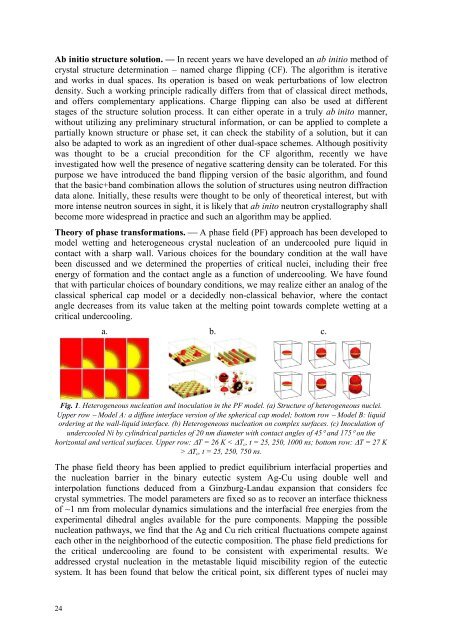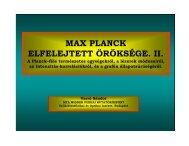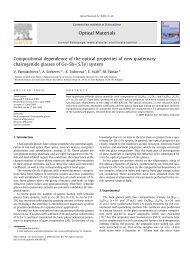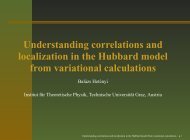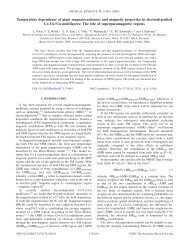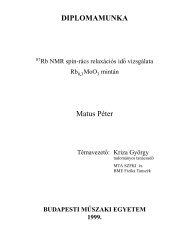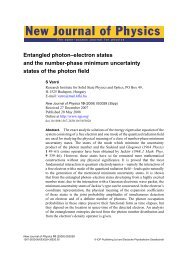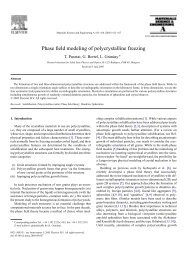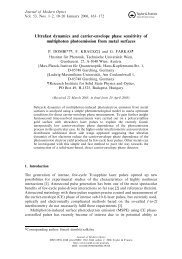ANNUAL REPORT - MTA SzFKI
ANNUAL REPORT - MTA SzFKI
ANNUAL REPORT - MTA SzFKI
Create successful ePaper yourself
Turn your PDF publications into a flip-book with our unique Google optimized e-Paper software.
Ab initio structure solution. — In recent years we have developed an ab initio method of<br />
crystal structure determination – named charge flipping (CF). The algorithm is iterative<br />
and works in dual spaces. Its operation is based on weak perturbations of low electron<br />
density. Such a working principle radically differs from that of classical direct methods,<br />
and offers complementary applications. Charge flipping can also be used at different<br />
stages of the structure solution process. It can either operate in a truly ab inito manner,<br />
without utilizing any preliminary structural information, or can be applied to complete a<br />
partially known structure or phase set, it can check the stability of a solution, but it can<br />
also be adapted to work as an ingredient of other dual-space schemes. Although positivity<br />
was thought to be a crucial precondition for the CF algorithm, recently we have<br />
investigated how well the presence of negative scattering density can be tolerated. For this<br />
purpose we have introduced the band flipping version of the basic algorithm, and found<br />
that the basic+band combination allows the solution of structures using neutron diffraction<br />
data alone. Initially, these results were thought to be only of theoretical interest, but with<br />
more intense neutron sources in sight, it is likely that ab inito neutron crystallography shall<br />
become more widespread in practice and such an algorithm may be applied.<br />
Theory of phase transformations. ⎯ A phase field (PF) approach has been developed to<br />
model wetting and heterogeneous crystal nucleation of an undercooled pure liquid in<br />
contact with a sharp wall. Various choices for the boundary condition at the wall have<br />
been discussed and we determined the properties of critical nuclei, including their free<br />
energy of formation and the contact angle as a function of undercooling. We have found<br />
that with particular choices of boundary conditions, we may realize either an analog of the<br />
classical spherical cap model or a decidedly non-classical behavior, where the contact<br />
angle decreases from its value taken at the melting point towards complete wetting at a<br />
critical undercooling.<br />
a. b. c.<br />
Fig. 1. Heterogeneous nucleation and inoculation in the PF model. (a) Structure of heterogeneous nuclei.<br />
Upper row − Model A: a diffuse interface version of the spherical cap model; bottom row − Model B: liquid<br />
ordering at the wall-liquid interface. (b) Heterogeneous nucleation on complex surfaces. (c) Inoculation of<br />
undercooled Ni by cylindrical particles of 20 nm diameter with contact angles of 45° and 175° on the<br />
horizontal and vertical surfaces. Upper row: ∆T = 26 K < ∆T c , t = 25, 250, 1000 ns; bottom row: ∆T = 27 K<br />
> ∆T c , t = 25, 250, 750 ns.<br />
The phase field theory has been applied to predict equilibrium interfacial properties and<br />
the nucleation barrier in the binary eutectic system Ag-Cu using double well and<br />
interpolation functions deduced from a Ginzburg-Landau expansion that considers fcc<br />
crystal symmetries. The model parameters are fixed so as to recover an interface thickness<br />
of ~1 nm from molecular dynamics simulations and the interfacial free energies from the<br />
experimental dihedral angles available for the pure components. Mapping the possible<br />
nucleation pathways, we find that the Ag and Cu rich critical fluctuations compete against<br />
each other in the neighborhood of the eutectic composition. The phase field predictions for<br />
the critical undercooling are found to be consistent with experimental results. We<br />
addressed crystal nucleation in the metastable liquid miscibility region of the eutectic<br />
system. It has been found that below the critical point, six different types of nuclei may<br />
24


